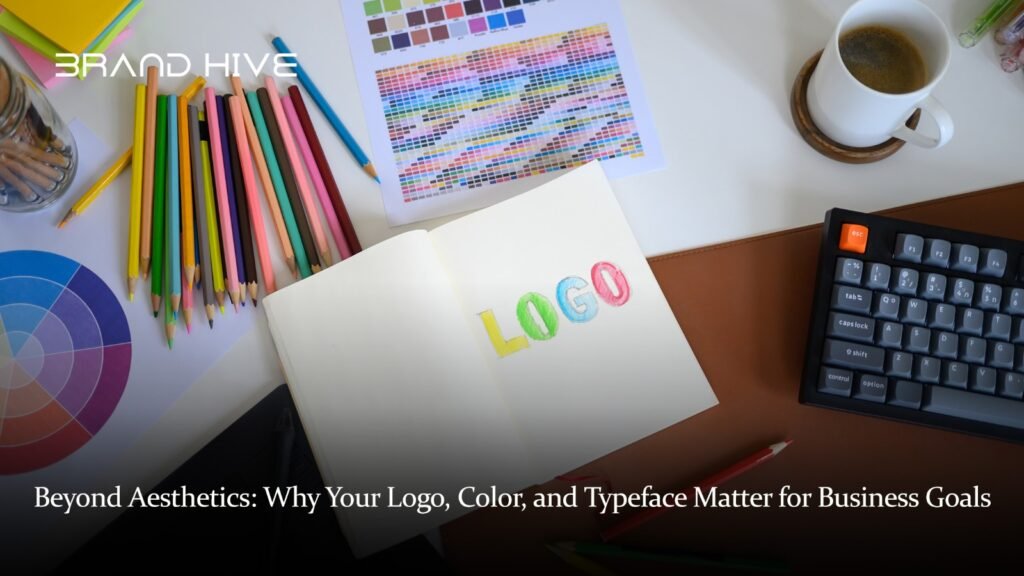When a business owner looks at their brand identity, the logo, the color palette, and the chosen fonts, they often see cost, design, or art. What they should be seeing, however, is strategy, recognition, and revenue. Your visual identity is not merely window dressing; it is the most visible expression of your underlying brand strategy. It’s the handshake, the uniform, and the first impression all rolled into one potent visual punch.
In the hyper-competitive marketplace, these three elements, your logo, color, and typeface, are crucial business tools that directly influence trust, recall, and ultimately, your bottom line.
1. The Logo: Your Business’s Visual Anchor and Strategy Flag
A logo is often mistaken for the entire brand, but it’s best described as the flag of your strategy. It’s the single graphic mark that summarizes everything your company is and aspires to be.
The primary business goal of a logo is to be instantly recognizable and memorable. Think of the Nike swoosh or the Apple icon, they are powerful because they are simple, distinct, and instantly recall a world of products, values, and experiences.
- Differentiation: A well-designed logo helps you stand out in a crowded market. If every competitor uses a generic geometric shape, an abstract, meaningful icon can be your unique differentiator, making it easier for customers to pick you out.
- Trust and Professionalism: A clean, professional, and well-executed logo signals stability and reliability. A poorly designed or amateur logo, conversely, can erode confidence before a customer even reads your first product description.
- Scalability and Adaptability: A good logo is a functional tool. It must work equally well on a billboard, a website favicon, a social media profile, or etched onto a tiny product. If your logo can’t scale or adapt, it hinders your marketing and production goals.
2. Color: The Psychology of Immediate Connection
Color is arguably the most powerful element of visual identity because its impact is primal, psychological, and immediate. It’s the first thing a human brain registers about your brand. Color choices are strategic decisions that tap into deep-seated emotional and cultural associations to influence consumer behavior.
Every color is associated with different feelings, and aligning these emotions with your brand values is a crucial strategic step.
| Color | Psychological Association | Brand Strategy Implication |
| Blue | Trust, Security, Stability, Intelligence | Ideal for finance, tech, and healthcare brands aiming to convey reliability. |
| Red | Excitement, Passion, Urgency, Danger | Used to capture attention and promote energy (e.g., in food, retail sales, or media). |
| Green | Health, Nature, Tranquility, Wealth | Perfect for sustainability, organic products, and financial institutions. |
| Yellow | Optimism, Clarity, Warmth, Joy | Used by brands targeting families or looking to project friendliness and accessibility. |
- Consistency is Key: Choosing a color palette is only half the battle. Consistently using the exact color codes across every channel from your website to your packaging, reinforces memorability. This consistency reduces customer effort in recognizing your brand, a key business efficiency.
- Differentiation by Absence: Sometimes, a unique color is all the strategy you need. Think of the distinct purple of Cadbury or the vibrant orange of easyJet. These colors act as proprietary assets, making it difficult for competitors to use the same palette without looking derivative.
3. Typeface: The Voice You Read
If your logo is the flag and your color is the emotion, your typeface (or font family) is the written voice of your brand. It’s what conveys your brand’s tone, personality, and professionalism in every piece of communication.
The selection of a font is a deliberate act of choosing a personality. Do you want to sound traditional and established (a classic Serif), modern and approachable (a clean Sans-Serif), or quirky and unique (a Custom or Display font)?
- Legibility as a Business Requirement: A primary goal of typography is to ensure text is easy to read. If a customer struggles to read your product name, a call-to-action, or an important feature, the font is directly failing a core business objective: communication. Poor legibility is a loss of potential sales or service uptake.
- The Power of Customization: Many global brands use custom-designed fonts. This strategic move locks in brand uniqueness, prevents competitors from mimicking their exact voice, and can even save on licensing fees over time.
- Conveying Tone: A strong, bold sans-serif might convey confidence and authority (great for B2B tech), while an elegant, thin serif might suggest luxury and heritage (perfect for high-end fashion). The typeface ensures that the visual tone matches the written tone, reinforcing consistency.
Final Thoughts: Visual Identity as a Business Asset
Your logo, color, and typeface are much more than graphic elements; they are strategic assets that drive business goals:
- They Increase Awareness: By being distinct and consistent.
- They Build Trust: By appearing professional and reliable.
- They Guide Perception: By leveraging powerful emotional psychology.
- They Support Marketing: By providing a unified, scalable system for all communications.
Ignoring the strategic importance of your visual identity is like trying to build a skyscraper without an architectural blueprint. It might stand for a while, but it won’t be as strong, recognizable, or valuable as it could be.
A robust visual identity requires a deep understanding of your business goals, your target audience’s psychology, and the competitive landscape. If you’re looking to transform your visual elements from simple decoration into potent business tools, a strategic partner is essential. Brand Hive, the best branding company in Dubai, can help you develop a cohesive and impactful visual identity that perfectly aligns with your overarching business goals.

